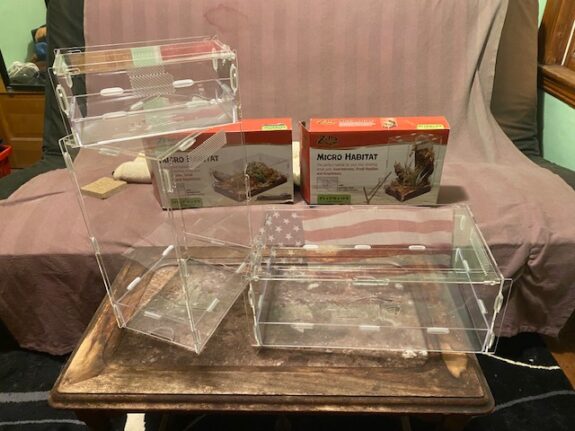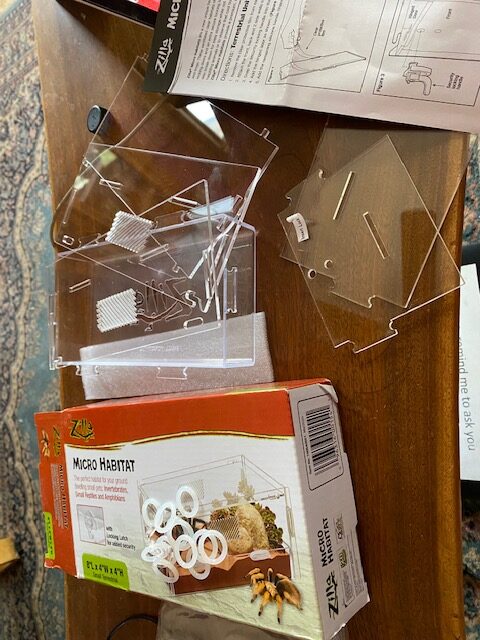Zilla has produced a variety of “Micro habitats”. Gecko Time received three of them to review: The “Small Terrestrial” (8”x4”x4”), the “Large Terrestrial (14″x8″x6”) and the “Large Arboreal” (8″x6″x14″). At approximately $20-30 each, they are reasonably priced, though it’s probably not practical to use them as a display system that would require purchasing many of them.
The habitats come unassembled in brightly colored boxes.

As you can see, the dimensions are prominently displayed in large print and in (green) contrasting color. The pictures on the box show generally appropriate use of the habitat. However, there is an illustration on the “Large Arboreal” box which pictures an unspecified day gecko as well as 2 arboreal frogs housed together. This is marginal in a very large habitat and unacceptable in an 8″x6″x14″ enclosure. All the habitats are advertised as a place to house small reptiles, amphibians and invertebrates or to temporarily house creatures caught outdoors in order to observe them.
Assembly
The habitats are easy to assemble and are all assembled the same way. In fact, the same set of directions, covering assembly of all the micro habitats, is enclosed in each box.

After reviewing the instructions, each micro habitat could be assembled in 5-10 minutes. Each habitat consists of an acrylic base and 5 vertical and horizontal panels, one of which is a hinged door with a safety lock. The base can hold water and the panels are held together by a combination of tabs and slots and silicon rings slipped around the protruding tabs. The habitat can be disassembled in the same amount of time and stored efficiently when it’s not being used. Some of the panels include ventilation holes.
Each clear acrylic panel is shipped with protective plastic film covering both sides. The film needs to be peeled off before assembly. There is a small problem with this, since there is a label on one panel indicating which side the locking mechanism needs to be installed. Unfortunately, the label is on the outside of the plastic film, so it comes off when the film is peeled off. It would have been better placed under the plastic film.

Impressions
I found the habitats to be very well constructed with overlapping pieces to prevent creatures escaping out the sides. By contrast, when housing small geckos in some of the more well-known small habitats, it was necessary to tape many of the areas where the sides or top come together in order to prevent gecko escapes (I learned the hard way!).
There are many positives about these enclosures: elegant design, ease of storage, assembly and disassembly to mention a few. The biggest problem with these micro habitats from the perspective of the gecko keeper is that for the most part they are too small to be used as permanent enclosures for a gecko, despite the claim that they will house “small reptiles”. At most, the “Large Terrestrial”, which is similar in size to a 6 quart “shoebox” tub, could house gecko hatchlings for a short period of time. The “Large Arboreal”, which has the same dimensions as the “Large Terrestrial” but oriented vertically, could house gargoyle or crested gecko hatchlings for a short period of time. I do keep some micro geckos in similarly sized enclosures (8″x8″x12″) but I would worry about these tiny geckos, which can climb, escaping through the vent slots.
The habitats contain a warning against placing heat or lighting directly on them, since this can melt the acrylic. This is another consideration for those who may want to house small geckos that need basking lights.
Uses
So what would a gecko keeper do with these habitats? In addition to temporary housing for hatchlings, a few things come to mind:
–Storage for feeders including worms, crickets, and roaches. Care should be taken, though, when attempting to contain pinhead crickets and very small roach nymphs, as they may be able to escape through the ventilation slots.
–Breeding location for isopods from outdoors before introducing them into bioactive enclosures.
–Vendor displays at reptile shows: many vendors display their geckos in individual deli cups or tiered display compartments. The micro habitats may be useful for vendors who have few geckos to display or who want to highlight specific geckos.
Gecko Time would be very interested to know what uses others have found for these attractive looking habitats. Feel free to drop us a line in the comments section.



